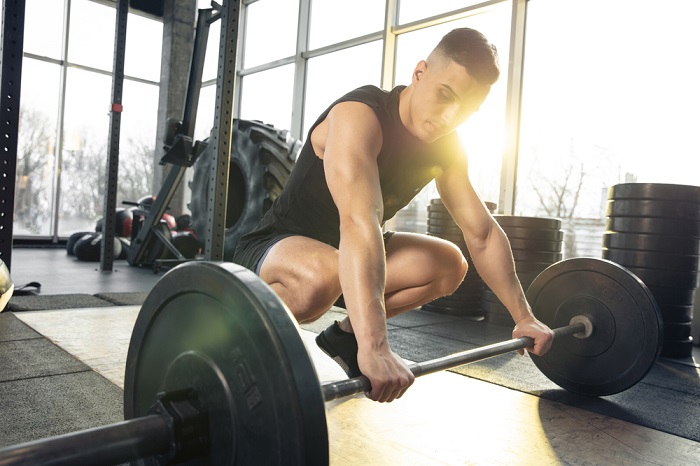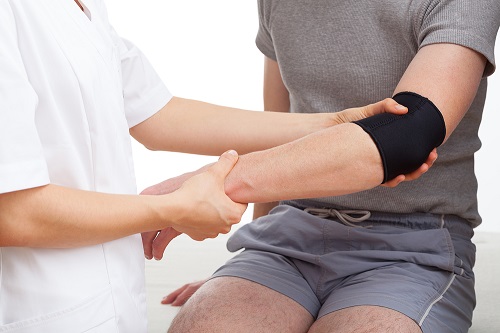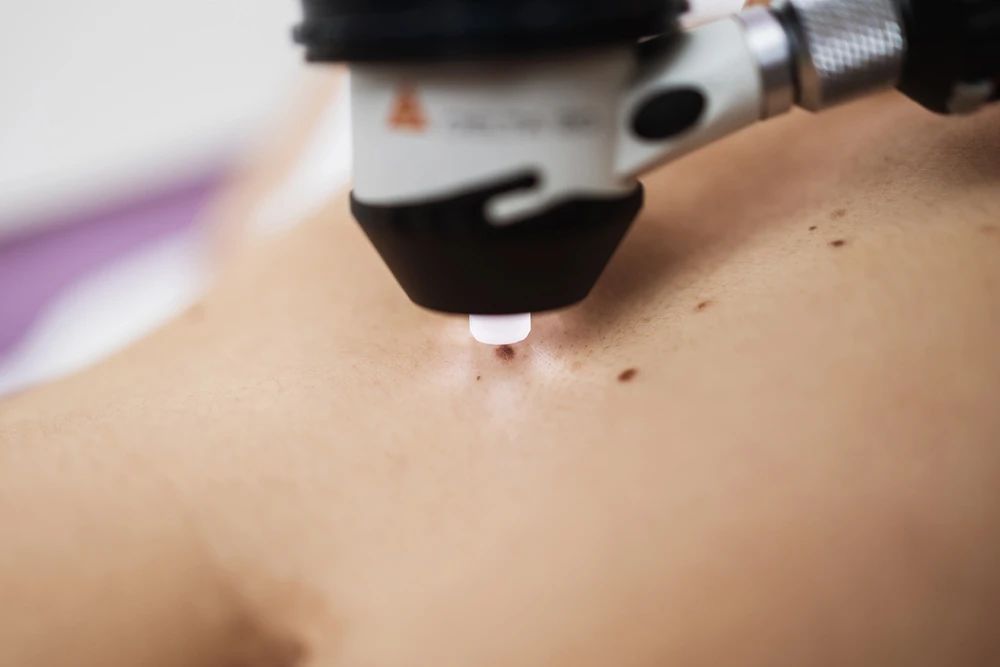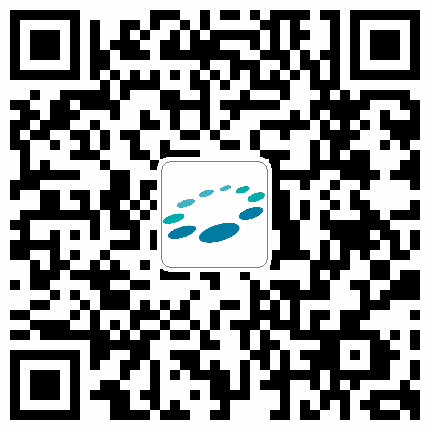Should I Continue CrossFit with a Sports Injury?
2021-02-18

Should you keep exercising when you have a sports injury?
We’ve all heard the saying ‘no pain, no gain’ but a CrossFit enthusiast may disagree.
If you’re out of shape, exercising may be uncomfortable for a while, and you’ll feel some aches as you use muscles that aren’t used to the work. But exercising shouldn’t be painful. Working through the pain when you have an injury is a bad idea, so you should know how to tell when the pain you are feeling is an injury, and when it is just soreness.
Muscle soreness and injury – what’s the difference?
Muscle soreness: When you exercise, you may feel muscular soreness 24 – 72 hours later. This is called delayed onset muscular soreness (DOMS) and is caused by small, safe damage to muscle fibers. Movement may be uncomfortable but stretching the affected muscles should decrease soreness. After a few days, the soreness will be completely gone.
Pain from injury: Unlike DOMS, pain from an injury will occur while or soon after performing an exercise. This pain may be sharp. If it doesn’t disappear after a few days, even after resting the affected muscles, it’s pretty conclusive you have injured yourself. Pushing through the pain to continue exercise can worsen the injury. If it doesn’t resolve within a week of rest, consult a doctor.
What are some common CrossFit injuries?
CrossFit is a comprehensive workout method that brings together different elements of physical fitness including aerobics, strength training, core building and balancing exercises. Workouts differ daily and typically take 60 minutes.
Here are some typical injuries arising from CrossFit exercises:
1. Tennis elbow

Tennis elbow, or lateral epicondylitis, is not only caused by playing tennis, but also from strain from repetitive movements. It is common in CrossFitters because the exercise regimen is often a series of repetitive movements.
What will I feel?
- Pain on the outside of your upper forearm, just below your elbow
- Pain when lifting or bending your arm
- Pain when gripping small objects like a pen
- Pain when turning a door handle or opening a jar
What should I do?
Stop your current activity until the pain goes away. Try stretches aimed at the extensor muscles and use a compression elbow brace to minimize micro-tears in muscles. And as with any injury, see your doctor or Physiotherapist should the pain persist.
2. Achilles tendonitis
Achilles tendonitis is an overuse injury of the Achilles tendon, the band of tissue that connects calf muscles at the back of the lower leg to your heel bone. You may experience this painful injury from doing too many high box jumps.
What will I feel?
You’ll feel a mild ache in the back of the leg or above the heel after exercise. More severe pain may occur after prolonged running, stair climbing or sprinting.
What should I do?
In most cases, rest is required at home under your doctor\'s supervision. Self-care strategies are usually necessary to prevent recurring episodes. Proper stretching and strengthening of the calf muscle are especially helpful.
Try heel inserts in your training shoes to prevent stress on the area. More serious cases of Achilles tendonitis can lead to tendon tears (ruptures) that may require surgical repair.
3. Rotator cuff tendonitis

The rotator cuff is a group of muscles and tendons that surround the shoulder joint, keeping the head of your upper arm bone firmly within the shoulder socket. Rotator cuff injuries occur most often in people who repeatedly perform overhead motions in their jobs or sports. CrossFitters may overdo ‘clean and jerk’ exercises and overhead presses, leading to rotator cuff tendonitis.
What may I experience?
- Dull ache in the shoulder, which often worsens when you try to sleep on the affected side
- Disturbed sleep, especially if you lie on the affected shoulder
- Difficulty in combing your hair or reaching behind your back
- Pain accompanied by arm weakness (see your doctor right away if you have immediate weakness in your arm after an injury)
What should I do?
Rest, apply ice and massage the area. Let the shoulder heal before doing exercises likely to cause rotator cuff tendonitis. Otherwise, you may end up with a very serious injury that requires surgery, or you may find yourself with a limited range of motion around the shoulder – for life.
4. De Quervain’s tenosynovitis
This is a painful condition affecting the tendons on the thumb side of your wrist and causes pain when the tendons are inflamed. While it is more common in women, the exact cause isn\'t known, and any activity that relies on repetitive hand or wrist movement can make it worse. CrossFitters may experience greater pain with kettlebell and barbell exercises.
What will I feel?
- Pain near the base of your thumb, which may be accompanied by swelling
- Difficulty moving your thumb and wrist when you\'re doing something that involves grasping or pinching
What should I do?
- Rest the area and apply cold ice daily
- Take some over-the-counter anti-inflammatories
- Gentle stretching of the tendons that run from the wrist into the thumb
- See your doctor or Physiotherapist if it doesn’t improve
5. Lower back pain
When you push your body beyond its limits, you may experience lower back pain. This happens because you’re not able to stabilize using your core muscles during athletic activities. Athletes and CrossFitters with lower back pain are often known to experience it when performing squats or deadlifts in particular.
Don’t ignore this pain and attempt to push through it as it will be harder to heal. While rehabilitation can help decrease your discomfort, the best way to treat lower back pain is to avoid it all together. To prevent lower back pain, stabilize your core so your spine stays in the neutral zone.
What will I feel?
You’ll feel a nagging pain that you think you can work through, but don’t be tempted to do so.
What should I do?
Do proper stretching and strengthening exercises to strengthen your core and the muscles that support your lower back. If you experience lower back pain, see your doctor or Physiotherapist for advice on suitable exercises you can do.
Avoid bed rest and consider massage to treat muscle tension. If you experience numbness, pain, or tingling in the arms or legs, seek medical advice. If you have loss of bladder control, seek immediate medical attention.
Your journey to get back to exercise after injury should be gradual and focused on strengthening your core under your Physiotherapist’s supervision.
How can I stay active when I’m injured?
- Seek your doctor’s advice before trying a new exercise program. Consider how you got injured in the first place and mentally prepare yourself to avoid injury again
- Start at about 50% of your usual activity level. Make sure you warm up and cool down before each session
- Try different types of activities, such as cycling or swimming, or something that doesn’t involve the injured area. This way, you can let your injury heal while you keep moving
- Listen to your body. If you feel pain, stop
How can I recover faster?
- Use the RICE (Rest, Ice, Compression and Elevation) method to help reduce the swelling involved in acute soft tissue injury
- Allow time to heal, and stop an activity if it causes pain
- Get an accurate diagnosis. If the injury doesn’t heal with rest, see a medical professional
- Improve joint motion with the help of a physiotherapist before returning to your sport
- Regain normal muscle strength. When you are ready, do muscle training exercises to gain back the strength lost through inactivity
- Take a diet designed to heal. Protein helps in muscle-building, vitamin C helps build tissues, and omega-3 fats prevent inflammation. Speak to a nutritionist about building a diet that will aid your recovery
Copyright: Health Plus an online health and wellness web resource developed by Parkway Singapore
References:
1. Whalen, S. The 5 Most Common Injuries in CrossFit. 12 February 2016. Retrieved 12 September 2018 from https://flexogenix.com/the-5-most-common-injuries-in-crossfit/
2. Tennis Elbow. 9 November 2017. Retrieved 12 September 2018 from https://www.nhs.uk/conditions/tennis-elbow/
3. Achilles Tendinitis. N.D. Retrieved 12 September 2018 from https://www.mayoclinic.org/diseases-conditions/achilles-tendinitis/symptoms-causes/syc-20369020
4. Rotator Cuff Injury. N.D. Retrieved 12 September 2018 from https://www.mayoclinic.org/diseases-conditions/rotator-cuff-injury/symptoms-causes/syc-20350225
5. De Quervain\'s tenosynovitis. N.D. Retrieved 12 September 2018 from https://www.mayoclinic.org/diseases-conditions/de-quervains-tenosynovitis/symptoms-causes/syc-20371332
6. Low Back pain is Not OK. N.D. Retrieved 12 September 2018 from https://sportmedbc.com/article/low-back-pain-not-ok
7. APTA. Soreness vs. Pain. What’s the Difference? N.D. Retrieved 12 September 2018 from https://www.moveforwardpt.com/resources/detail/soreness-vs-pain-whats-difference
8. Back on Track: Fitness After an Injury. N.D. Retrieved 12 September 2018 from https://www.webmd.com/fitness-exercise/exercise-after-injury





























